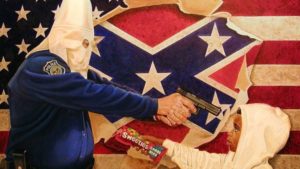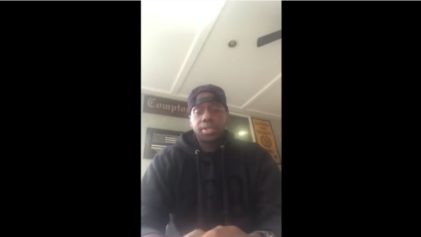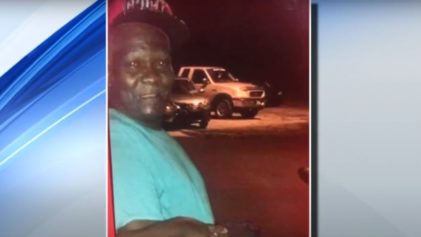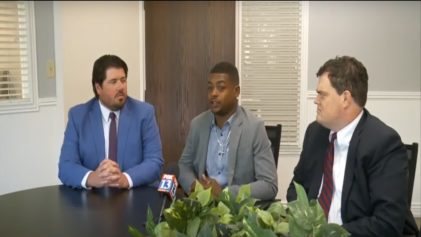
“A Tale of Two Hoodies” by Michael D’Antuono artandresponse.com)
The United States has been plagued as of late by the numerous killings of Black Americans at the hands of police. From the 2014 shooting death of Michael Brown in Ferguson, Missouri, to Deborah Danner, who was gunned down by an NYPD officer during a schizophrenic episode last week, there seems to be a new hashtag commemorating a life lost every other week.
Tensions between law enforcement and communities of color have festered for decades, but FBI director James Comey begs to differ.
According to PBS News Hour, Comey asserted last week that due to the lack of hard data on police use of force, there’s no way Black Americans can assume that racial bias plays a role in policing particular communities. In reference to public outcry over recent killings of Black people by police, the FBI director also said “the absence of good information” is only feeding the growing sentiment that police target communities of color.
“That is the narrative,” Comey told attendees of the International Association of Chiefs of Police last Sunday. “It is a narrative driven by video images of real misconduct, possible misconduct and perceived misconduct.”
But this is where Comey gets it wrong. Racial bias in law enforcement — specifically the presence of white supremacists in law enforcement — has been a major concern of the FBI for decades. In fact, 10 years ago this week, the agency warned of the consequences of white nationalist groups infiltrating local and state police agencies, PBS News Hour reports.
An FBI memo published in 2006 described the efforts of white supremacists and skinheads to infiltrate law enforcement and interrupt investigations into fellow members while recruiting other white nationalists. Officials voiced concern over the threat of white supremacists in law enforcement, noting that members had access to “restricted areas vulnerable to sabotage” and public officials who might be “potential targets of violence,” according to the news site.
Despite these facts, the FBI has remained largely quiet on the growing issue at a time when Black men and women are seemingly being gunned down by police on a weekly basis.
“Many people in these communities of color feel they have been the subject of police violence for decades,” said Samuel Jones, professor of law at Chicago’s John Marshall School of Law. “And when an officer engages in conduct that adds or enhances that divide, they are ultimately jeopardizing the integrity of their agencies and putting their fellow officers in danger.”
Instances of white supremacists hiding behind the badge and shield have occurred since the FBI’s report was released a decade ago. Atlanta Black Star reported in 2014 that three officers — including a deputy police chief — from the Fruitland Park Police Department in Florida were discovered to be loyal members of the Ku Klux Klan. A year later, a police officer in North Carolina was fired after a photo of him giving a Nazi salute was posted to Facebook.
Since then, police agencies across the nation launched investigations into officers who may have been members of recognized hate groups and/or faced accusations of racially charged misconduct, according to PBS News Hour. But some are still skeptical of government efforts to weed out potential troublemakers.
Virginia councilwoman Angelia Williams Graves expressed her thoughts regarding undercover racists in law enforcement during an annual NAACP luncheon last month, asserting that the bigots of today have rid themselves of their white cloaks and hoods in exchange for “police uniforms, suits and ties and robes.”
Many law enforcement officials found Graves’ remark insulting but failed to realize that the threat of white supremacists in positions of power is a legitimate concern for many Black Americans.
“Obviously, we do not want people with white supremacist or other extremist views to be in such positions, so it is important to screen them out,” said Heidi Beirich, director of the Intelligence Project at the Southern Poverty Law Center. “We catch them when we can, which means when we notice someone and check in the database.”
For Jones, the concern is that the FBI and police agencies themselves aren’t doing enough to remove white nationalists and the influence of white supremacy from law enforcement. He suggested that there be more direct action to rectify the problem.
“I cannot imagine that the FBI today could issue a report concerning any kind of threat without people being alarmed and wanting immediate action,” Jones said. “But in this case there seems to be almost an acceptance of it. The thought is, ‘It’s just ideology and they have a right to believe this.’ ”
“It’s one thing to issue a memo, and another to have continued action after it,” he added. “There was a warning 10 years ago and nothing else since then.”


